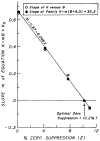USE OF AN OPTICAL DENSITY RULER IN MEASUREMENTS OF DYE-DILUTION CURVES
- PMID: 14155312
- PMCID: PMC3006161
- DOI: 10.1152/jappl.1964.19.2.347
USE OF AN OPTICAL DENSITY RULER IN MEASUREMENTS OF DYE-DILUTION CURVES
Abstract
The inapplicability of Beer’s law to densitometry of dyes in whole blood or other nonhomogeneous media has been long known. When using a densitometer whose output is directly proportional to the light transmitted, a simple transformation— log X = log (x − x0)—can be employed to allow rapid, accurate estimation of dye concentration. This is facilitated by use of an optical density ruler. The transformation, X = x − x0, can be made mechanically, by shifting the infinity position of the ruler with reference to the zero light transmission position, or electrically, by appropriate use of zero suppression in the densitometer circuit. The transformation results in an exponential (logarithmic) relationship between light transmitted and concentration of the dye (indocyanine green). Readings of relative optical density obtained by use of the ruler are multiplied by a calibration constant to calculate dye concentration. The principles of the transformation have been applied to the determination of the optimal zero suppression required for maintenance of constant sensitivity of the densitometer in the presence of various levels of background dye.
Figures







References
-
- Bassingthwaighte JB, Edwards AWT, Wood EH. Areas of dye-dilution curves sampled simultaneously from central and peripheral sites. J Appl Physiol. 1962;17:91–98. - PubMed
-
- Gaddum JH. Lognormal distributions. Nature. 1945;156:463–466.
-
- Hamilton WF, Moore JW, Kinsman JM, Spurling RG. Studies on circulation: Further analysis of injection method, and of changes in hemodynamics under physiological and pathological conditions. Am J Physiol. 1932;99:534–551.
MeSH terms
Substances
Grants and funding
LinkOut - more resources
Full Text Sources
Miscellaneous
